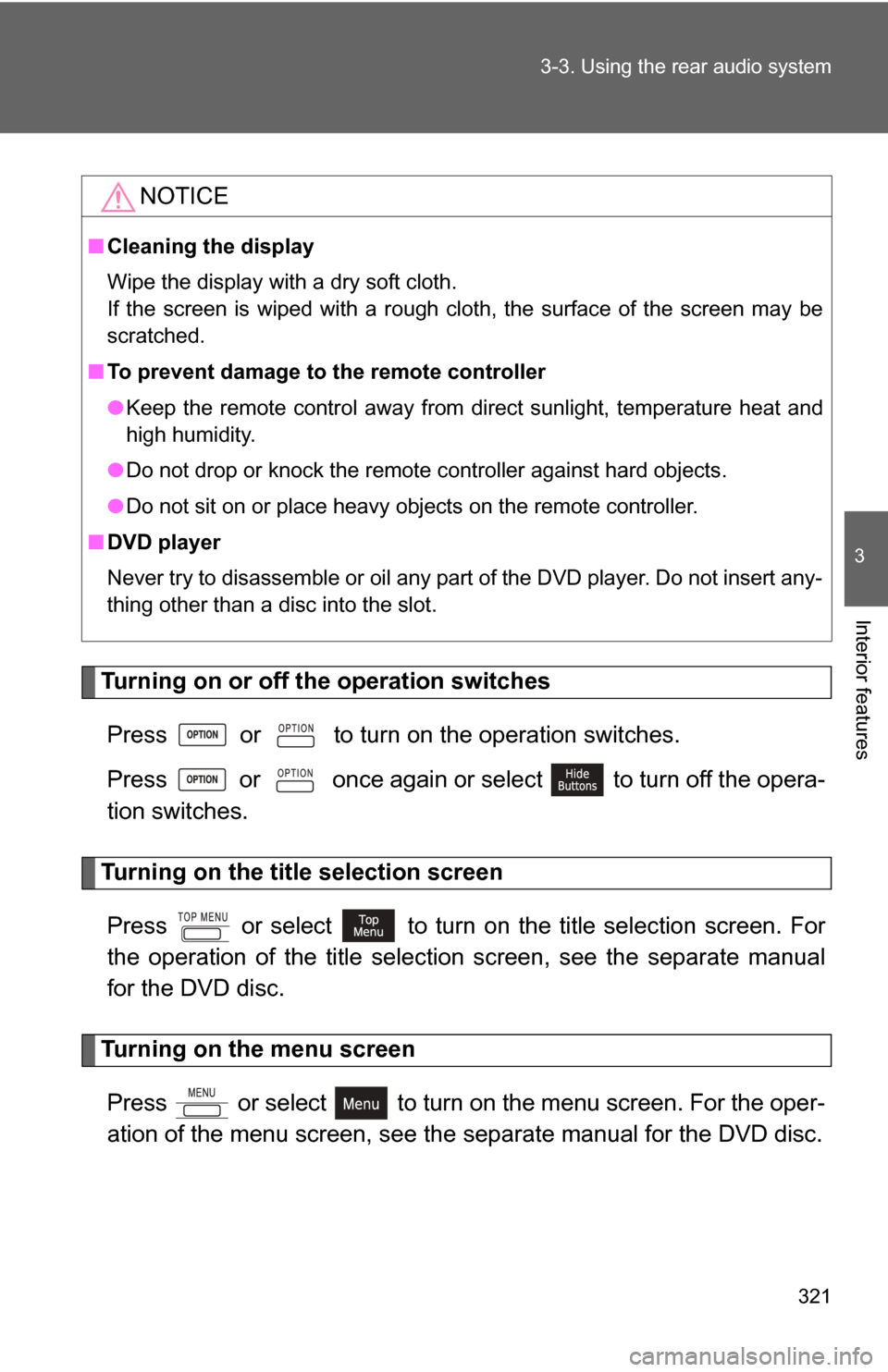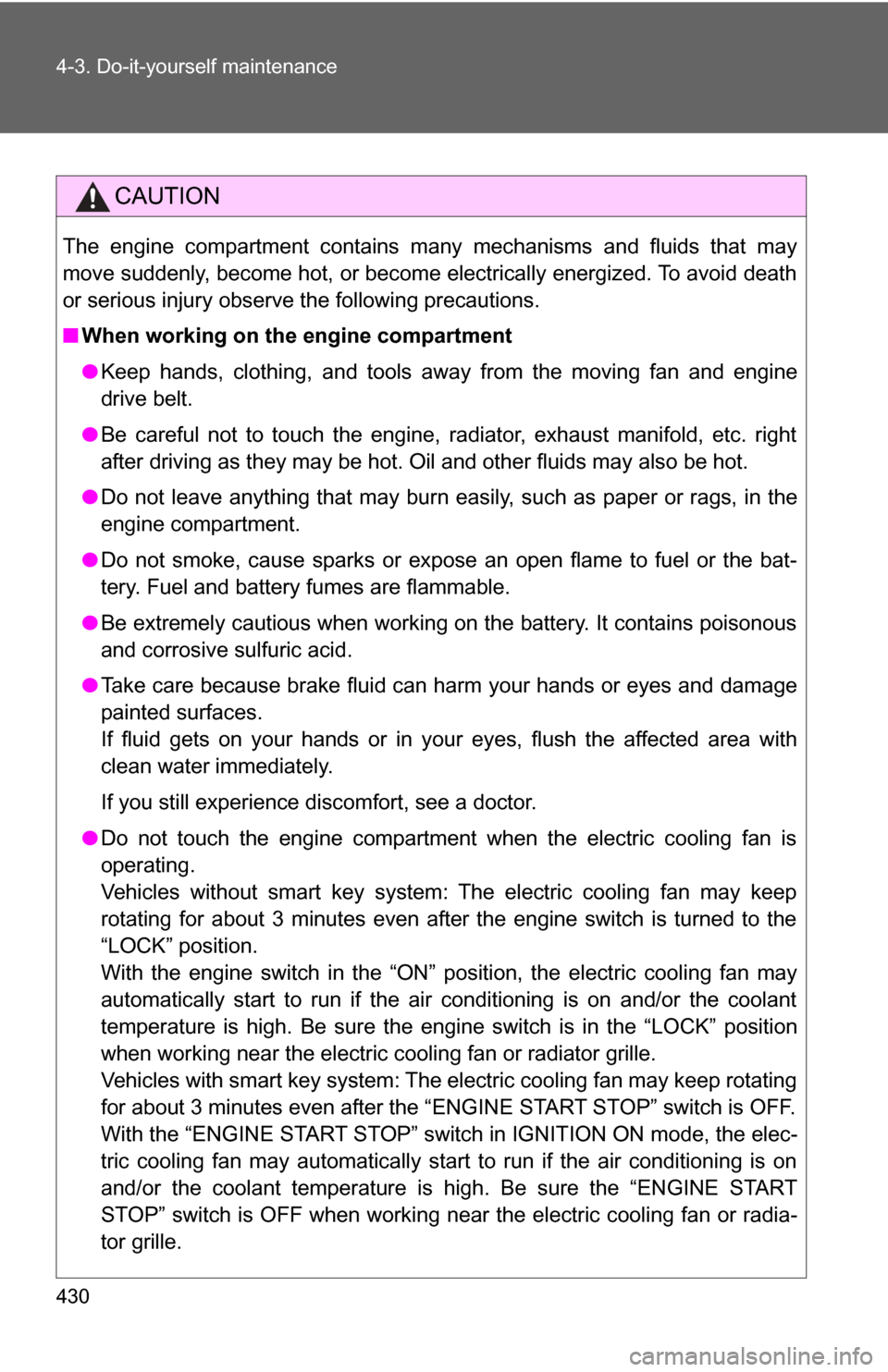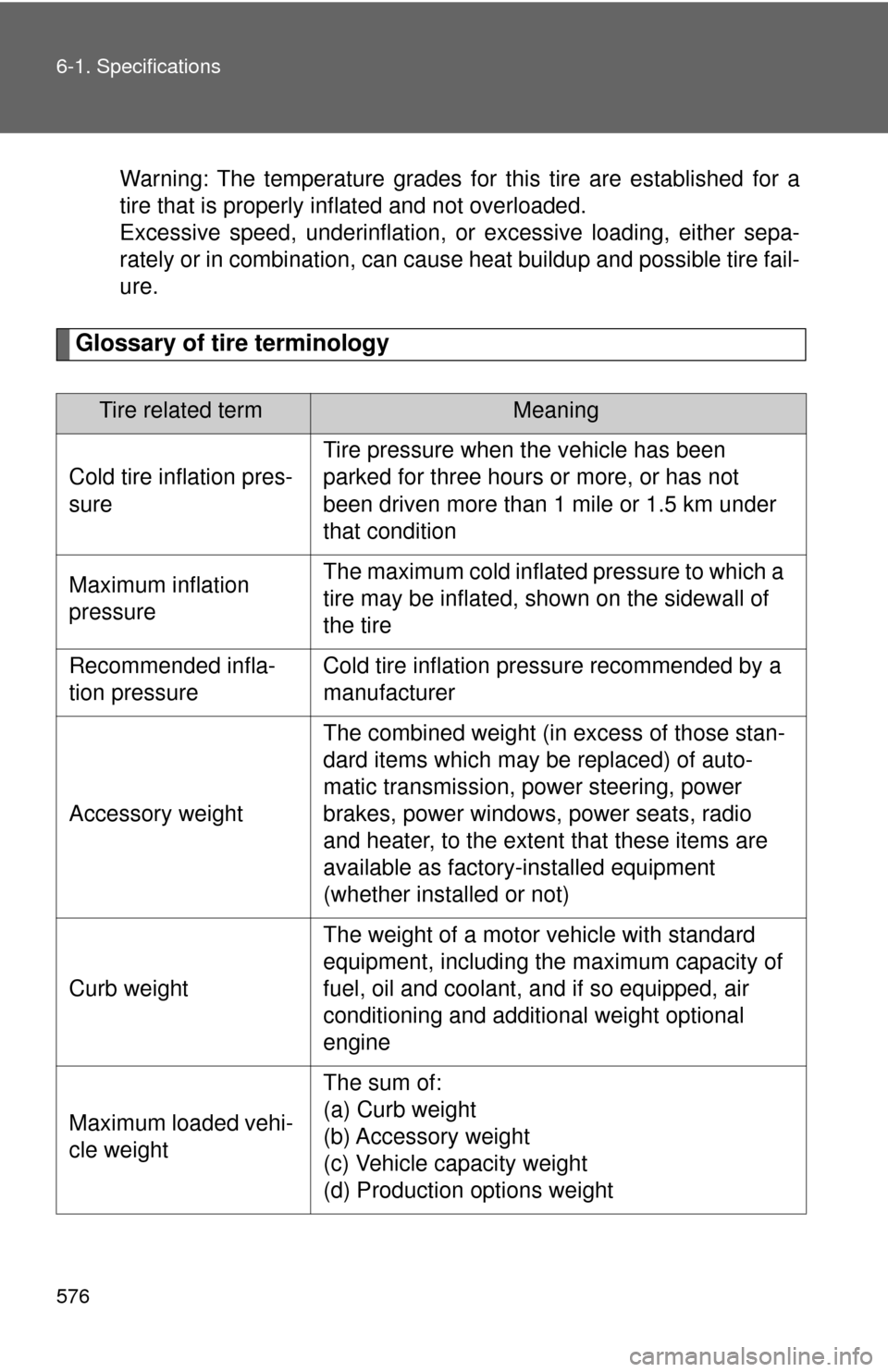Page 321 of 608

321
3-3. Using the rear audio system
3
Interior features
Turning on or off the operation switches
Press or to turn on the operation switches.
Press or once again or select to turn off the opera-
tion switches.
Turning on the title selection screenPress or select to turn on the title selection screen. For
the operation of the title selection screen, see the separate manual
for the DVD disc.
Turning on the menu screen
Press or select to turn on the menu screen. For the oper-
ation of the menu screen, see the separate manual for the DVD disc.
NOTICE
■Cleaning the display
Wipe the display with a dry soft cloth.
If the screen is wiped with a rough cloth, the surface of the screen may be
scratched.
■ To prevent damage to the remote controller
●Keep the remote control away from direct sunlight, temperature heat and
high humidity.
● Do not drop or knock the remote controller against hard objects.
● Do not sit on or place heavy objects on the remote controller.
■ DVD player
Never try to disassemble or oil any part of the DVD player. Do not insert any-
thing other than a disc into the slot.
Page 430 of 608

430 4-3. Do-it-yourself maintenance
CAUTION
The engine compartment contains many mechanisms and fluids that may
move suddenly, become hot, or become electrically energized. To avoid death
or serious injury observe the following precautions.
■When working on the engine compartment
●Keep hands, clothing, and tools away from the moving fan and engine
drive belt.
● Be careful not to touch the engine, radiator, exhaust manifold, etc. right
after driving as they may be hot. Oil and other fluids may also be hot.
● Do not leave anything that may burn easily, such as paper or rags, in the
engine compartment.
● Do not smoke, cause sparks or expose an open flame to fuel or the bat-
tery. Fuel and battery fumes are flammable.
● Be extremely cautious when working on the battery. It contains poisonous
and corrosive sulfuric acid.
● Take care because brake fluid can harm your hands or eyes and damage
painted surfaces.
If fluid gets on your hands or in your eyes, flush the affected area with
clean water immediately.
If you still experience discomfort, see a doctor.
● Do not touch the engine compartment when the electric cooling fan is
operating.
Vehicles without smart key system: The electric cooling fan may keep
rotating for about 3 minutes even after the engine switch is turned to the
“LOCK” position.
With the engine switch in the “ON” position, the electric cooling fan may
automatically start to run if the air conditioning is on and/or the coolant
temperature is high. Be sure the engine switch is in the “LOCK” position
when working near the electric cooling fan or radiator grille.
Vehicles with smart key system: The electric cooling fan may keep rotating
for about 3 minutes even after the “ENGINE START STOP” switch is OFF.
With the “ENGINE START STOP” switch in IGNITION ON mode, the elec-
tric cooling fan may automatically start to run if the air conditioning is on
and/or the coolant temperature is high. Be sure the “ENGINE START
STOP” switch is OFF when working near the electric cooling fan or radia-
tor grille.
Page 440 of 608
440 4-3. Do-it-yourself maintenance
Engine oilWith the engine at operating temperature and turned off, check the oil
level on the dipstick.
■ Checking the engine oil
Park the vehicle on level ground. After turning off the engine,
wait more than five minutes for the oil to drain back into the
bottom of the engine.
Hold a rag under the end and
pull the dipstick out.
Wipe the dipstick clean.
Reinsert the dipstick fully.
Holding a rag under the end, pull the dipstick out and check
the oil level.
Wipe the dipstick and reinsert it fully.
2.7 L 4-cylinder (1AR-FE) engine
Low
Full
STEP1
STEP2
STEP3
STEP4
STEP5
STEP6
Page 442 of 608
442 4-3. Do-it-yourself maintenance
■Recommended viscosity (2.7 L 4-cylinder (1AR-FE) engine)
SAE 5W-20 or 0W-20 engine oil
may be used. However, SAE
0W-20 is the best choice for
good fuel economy and good
starting in cold weather.
■ Recommended viscosity (3.5 L V6 (2GR-FE) engine)
Without towing package
SAE 5W-20 is the best choice for
good fuel economy, and good
starting in cold weather.
With towing package SAE 5W-30 is the best choice for
good fuel economy, and good
starting in cold weather.
*: If SAE 5W-30 oil is not avail-able, SAE 10W-30 oil may be
used. However, it should be
replaced with SAE 5W-30 at
the next oil change.
Outside temperature
Outside temperature
Outside temperature
Page 557 of 608
557
6-1. Specifications
6
Vehicle specifications
Recommended oil
viscosity (2.7 L 4-cylinder
(1AR-FE) engine)
Use Toyota approved “Toyota Genuine Motor
Oil” or equivalent to satisfy the grade and vis-
cosity shown below.
Recommended oil
viscosity (3.5 L V6 (2GR-
FE) engine)Use Toyota approved “Toyota Genuine Motor
Oil” or equivalent to satisfy the grade and vis-
cosity shown below.
Vehicles without towing package
Vehicles with towing package
Outside temperature
Outside temperature
Outside temperature
Page 558 of 608

558 6-1. Specifications
Oil viscosity
●The 5W portion of the oil viscosity rating indicates the characteristic
of the oil which allows cold startabi lity. Oils with a lower value before
the W allow for easier starting of the engine in cold weather.
● The 30 in 5W-30 indicates the oil visc osity when the oil is at its oper-
ating temperature. An oil with a hi gher viscosity may be better suited
if the vehicle is operated at high speeds, or under extreme load con-
ditions.
Cooling system
*: With towing package
Capacity
(Reference)
2.7 L 4-cylin-
der (1AR-FE)
engine Without rear air conditioning system
7.3 qt. (6.9 L, 6.1 Imp. qt.)
8.0 qt. (7.6 L, 6.7 Imp. qt.)*
With rear air conditioning system
9.6 qt. (9.1 L, 8.0 Imp. qt.)
10.4 qt. (9.8 L, 8.6 Imp. qt.)*
3.5 L V6
(2GR-FE)
engine Without rear air conditioning system
9.3 qt. (8.8 L, 7.7 Imp. qt.)
10.0 qt. (9.5 L, 8.4 Imp. qt.)*
With rear air conditioning system
11.6 qt. (11.0 L, 9.7 Imp. qt.)
12.4 qt. (11.7 L, 10.3 Imp. qt.)*
Coolant type Use either of the following.
• “Toyota Super Long Life Coolant”
• Similar high-quality ethylene glycol-based non-silicate, non-amine, non-nitrite, and
non-borate coolant with long-life hybrid
organic acid technology
Do not use plain water alone.
Page 576 of 608

576 6-1. Specifications
Warning: The temperature grades for this tire are established for a
tire that is properly inflated and not overloaded.
Excessive speed, underinflation, or excessive loading, either sepa-
rately or in combination, can cause heat buildup and possible tire fail-
ure.
Glossary of tire terminology
Tire related termMeaning
Cold tire inflation pres-
sure Tire pressure when the vehicle has been
parked for three hours or more, or has not
been driven more than 1 mile or 1.5 km under
that condition
Maximum inflation
pressure The maximum cold inflated
pressure to which a
tire may be inflated, s hown on the sidewall of
the tire
Recommended infla-
tion pressure Cold tire inflation pressure recommended by a
manufacturer
Accessory weight The combined weight (in excess of those stan-
dard items which may be replaced) of auto-
matic transmission, power steering, power
brakes, power windows, power seats, radio
and heater, to the extent that these items are
available as factory-installed equipment
(whether installed or not)
Curb weight The weight of a motor vehicle with standard
equipment, including the maximum capacity of
fuel, oil and coolant, and if so equipped, air
conditioning and additional weight optional
engine
Maximum loaded vehi-
cle weight The sum of:
(a) Curb weight
(b) Accessory weight
(c) Vehicle capacity weight
(d) Production options weight
Page 596 of 608

596 Alphabetical index
Electric power steering ........... 218
Electronic keyIf your electronic key battery is discharged .......................... 539
Emergency flashers
Switch.................................... 498
Emergency, in case of If the back door opener is
inoperative ............................74
If the electronic key does not operate properly.................. 539
If the engine will not start ...... 535
If the shift lever cannot be shifted from P...................... 537
If the vehicle has a discharged battery ................................. 541
If the warning buzzer
sounds... ............................ 510
If the warning light turns on ........................................ 510
If the warning message is displayed............................. 521
If you have a flat tire ............. 522
If you lose your keys/
wireless remote control
transmitter ........................... 538
If you think something is wrong .................................. 506
If your vehicle becomes
stuck ................................... 548
If your vehicle needs to be towed .................................. 499
If your vehicle overheats ....... 545 Engine
Compartment ........................ 437
Engine switch ................ 173, 177
Hood ..................................... 432
How to start the
engine ......................... 173, 177
Identification number............. 553
If the engine will not start ...... 535
Ignition switch ............... 173, 177
Overheating .......................... 545
Engine compartment cover .... 439
Engine coolant
Capacity ................................ 558
Checking ............................... 445
Preparing and checking before winter .................................. 238
Engine coolan t temperature
gauge ...................................... 188
Engine immobilizer system .... 115
Engine oil Capacity ................................ 556
Checking ............................... 440
Preparing and checking before winter .................................. 238
Engine oil maintenance data ......................................... 443
Enhanced vehicle stability control .................................... 218
Enhanced VSC ......................... 218
EPS............................................ 218
Event data recorder ................. 508E